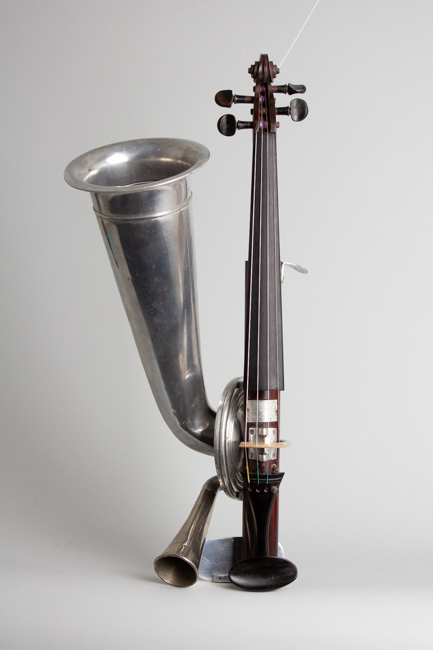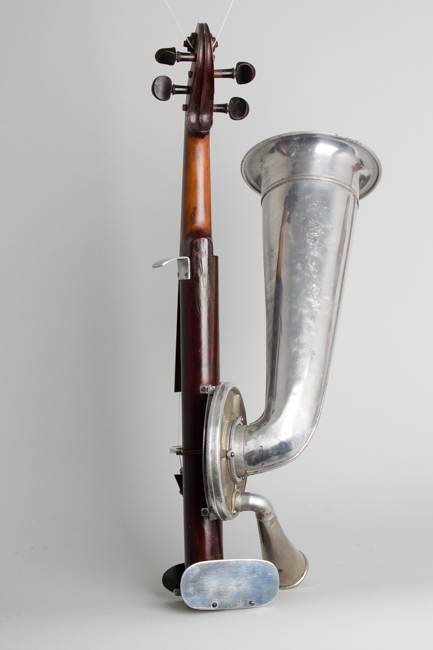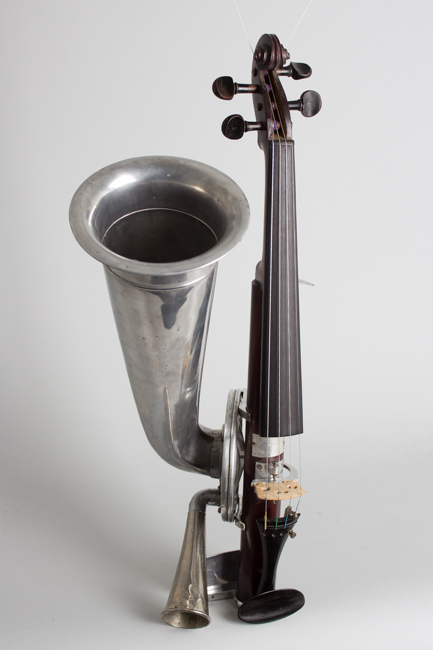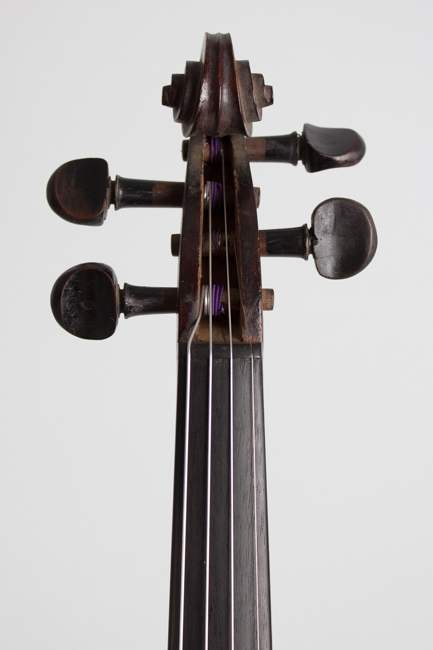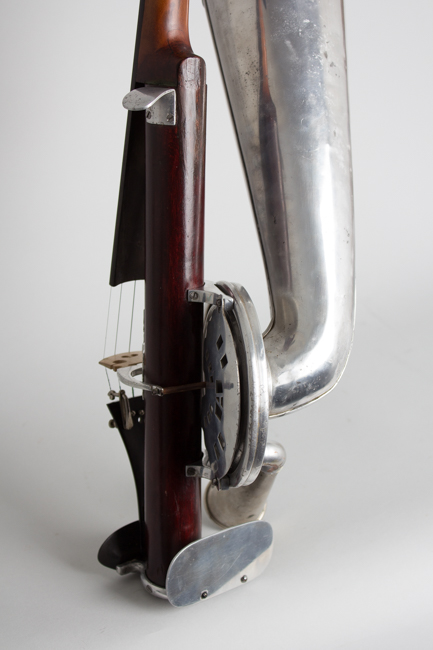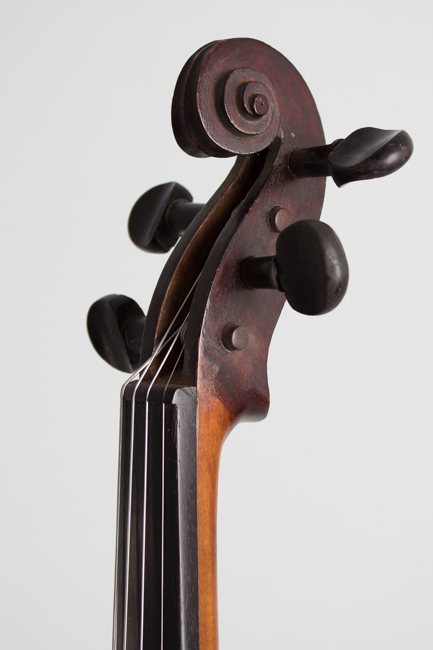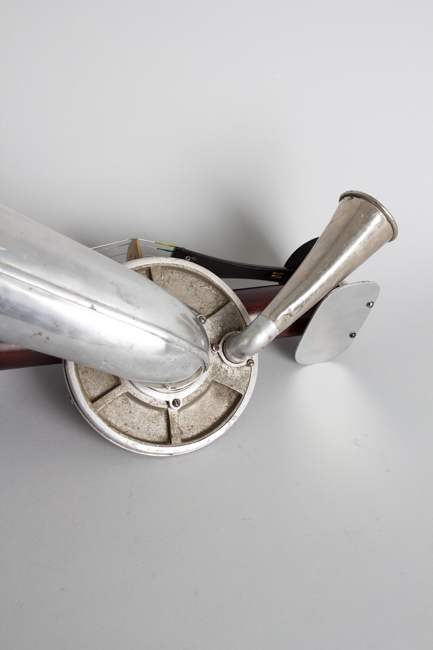Resophonic Violin (maker unknown) , c. 1910
Resophonic Violin (maker unknown), c. 1910, probably European, natural wood and aluminum finish, wood body, ebony fingerboard, aluminum fittings.
This is a very rare and unusual Stroviols style resophonic violin. The instrument lacks a maker's mark but it is clearly a close period copy of the Stroviols instrument design, with some minor variations. The most notable difference is the round plate protecting the delicate cone, a useful feature actual Stroviols instruments lack. The chin and shoulder rest design differs slightly but aside from aesthetics function the same. The bridge design on this instrument differs slightly as well as it is adjustable via two screws allowing you to move it forward and backwards, likely for intonation purposes. A more budget-conscious difference on this instrument are the tuning pegs, which are made from dyed wood as opposed to genuine ebony.
The sound of this instrument is very similar, if not essentially identical to an authentic Stroviol. These instruments produce a more compressed slightly metallic tone compared to a wood bodied instrument, yet still full and in its own way quite beautiful. This is a very fine playing and nice-sounding example, showing not too much wear overall, generally well maintained over the past 100+ years and properly set up for playability.
Oddly enough Augustus Stroh failed to patent his inventions in the USA which allowed John Dopyera and George Beauchamp to subsequently obtain US patents for the tricone and single cone designs used in National resonator instruments, as well as later Dobros. Stroh violins were somewhat successful for a couple of decades, especially in the era of acoustical recording, at which they excelled. 120+ years on the sound and look are still both classy and outrageous, with an enduring appeal to collectors and violinists of an adventurous nature.
Overall length is 22 1/2 in. (57.2 cm.), 5 7/8 in. (14.9 cm.) diameter of bell. Scale length is 12 3/4 in. (324 mm.). Width of nut is 1 in. (25 mm.).
This is a very good and fully playable example of a very unusual and extremely rare instrument, appearing lightly played but not heavily worn. There is some loss to the stained finish on the back of the neck down to the wood. By comparison the finish on the barrel body is quite good, with hardly any wear. The metal pieces are overall well preserved with some corrosion on the plate attached to the barrel.
The large horn is in very fine condition with some small dents and a nice overall shine. The bell flare is nice and even with no dents. The smaller monitor horn is a neatly done replacement, made of a bell from a schalmei horn and a bent piece of plumbing. All other parts are original and the instrument plays quite well with a very powerful and focused sound. No case. Overall Good Condition.
This is a very rare and unusual Stroviols style resophonic violin. The instrument lacks a maker's mark but it is clearly a close period copy of the Stroviols instrument design, with some minor variations. The most notable difference is the round plate protecting the delicate cone, a useful feature actual Stroviols instruments lack. The chin and shoulder rest design differs slightly but aside from aesthetics function the same. The bridge design on this instrument differs slightly as well as it is adjustable via two screws allowing you to move it forward and backwards, likely for intonation purposes. A more budget-conscious difference on this instrument are the tuning pegs, which are made from dyed wood as opposed to genuine ebony.
The sound of this instrument is very similar, if not essentially identical to an authentic Stroviol. These instruments produce a more compressed slightly metallic tone compared to a wood bodied instrument, yet still full and in its own way quite beautiful. This is a very fine playing and nice-sounding example, showing not too much wear overall, generally well maintained over the past 100+ years and properly set up for playability.
Oddly enough Augustus Stroh failed to patent his inventions in the USA which allowed John Dopyera and George Beauchamp to subsequently obtain US patents for the tricone and single cone designs used in National resonator instruments, as well as later Dobros. Stroh violins were somewhat successful for a couple of decades, especially in the era of acoustical recording, at which they excelled. 120+ years on the sound and look are still both classy and outrageous, with an enduring appeal to collectors and violinists of an adventurous nature.
Overall length is 22 1/2 in. (57.2 cm.), 5 7/8 in. (14.9 cm.) diameter of bell. Scale length is 12 3/4 in. (324 mm.). Width of nut is 1 in. (25 mm.).
This is a very good and fully playable example of a very unusual and extremely rare instrument, appearing lightly played but not heavily worn. There is some loss to the stained finish on the back of the neck down to the wood. By comparison the finish on the barrel body is quite good, with hardly any wear. The metal pieces are overall well preserved with some corrosion on the plate attached to the barrel.
The large horn is in very fine condition with some small dents and a nice overall shine. The bell flare is nice and even with no dents. The smaller monitor horn is a neatly done replacement, made of a bell from a schalmei horn and a bent piece of plumbing. All other parts are original and the instrument plays quite well with a very powerful and focused sound. No case. Overall Good Condition.
